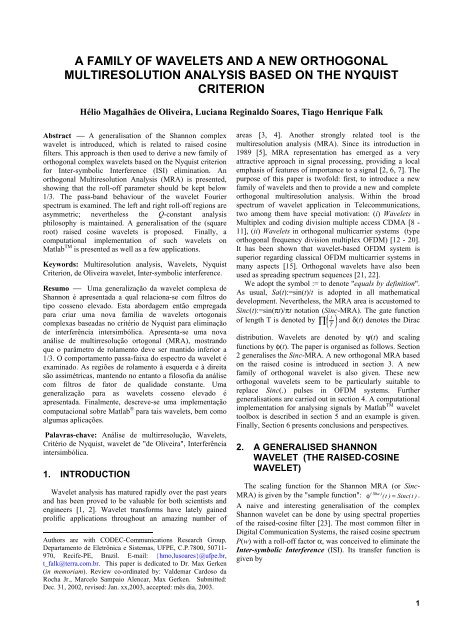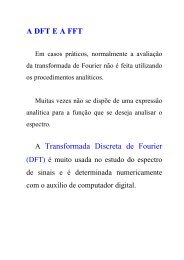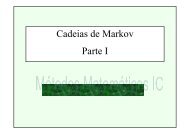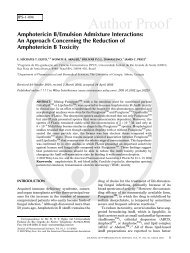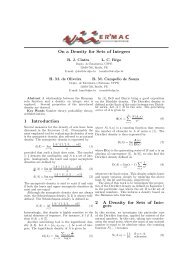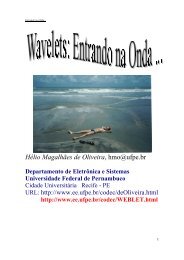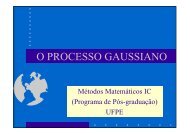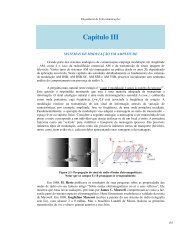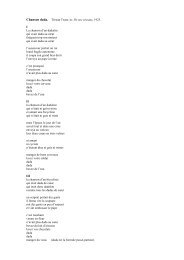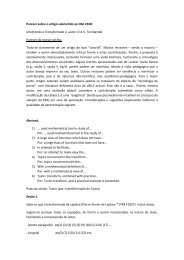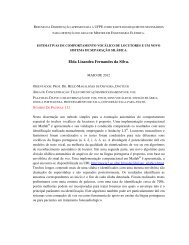A Family of Wavelets and ...
A Family of Wavelets and ...
A Family of Wavelets and ...
You also want an ePaper? Increase the reach of your titles
YUMPU automatically turns print PDFs into web optimized ePapers that Google loves.
A FAMILY OF WAVELETS AND A NEW ORTHOGONAL<br />
MULTIRESOLUTION ANALYSIS BASED ON THE NYQUIST<br />
CRITERION<br />
Hélio Magalhães de Oliveira, Luciana Reginaldo Soares, Tiago Henrique Falk<br />
Abstract . ⎯ A generalisation <strong>of</strong> the Shannon complex<br />
wavelet is introduced, which is related to raised cosine<br />
filters. This approach is then used to derive a new family <strong>of</strong><br />
orthogonal complex wavelets based on the Nyquist criterion<br />
for Inter-symbolic Interference (ISI) elimination. An<br />
orthogonal Multiresolution Analysis (MRA) is presented,<br />
showing that the roll-<strong>of</strong>f parameter should be kept below<br />
1/3. The pass-b<strong>and</strong> behaviour <strong>of</strong> the wavelet Fourier<br />
spectrum is examined. The left <strong>and</strong> right roll-<strong>of</strong>f regions are<br />
asymmetric; nevertheless the Q-constant analysis<br />
philosophy is maintained. A generalisation <strong>of</strong> the (square<br />
root) raised cosine wavelets is proposed. Finally, a<br />
computational implementation <strong>of</strong> such wavelets on<br />
Matlab TM is presented as well as a few applications.<br />
Keywords: Multiresolution analysis, <strong>Wavelets</strong>, Nyquist<br />
Criterion, de Oliveira wavelet, Inter-symbolic interference.<br />
Resumo . ⎯ Uma generalização da wavelet complexa de<br />
Shannon é apresentada a qual relaciona-se com filtros do<br />
tipo cosseno elevado. Esta abordagem então empregada<br />
para criar uma nova família de wavelets ortogonais<br />
complexas baseadas no critério de Nyquist para eliminação<br />
de interferência intersimbólica. Apresenta-se uma nova<br />
análise de multirresolução ortogonal (MRA), mostr<strong>and</strong>o<br />
que o parâmetro de rolamento deve ser mantido inferior a<br />
1/3. O comportamento passa-faixa do espectro da wavelet é<br />
examinado. As regiões de rolamento à esquerda e à direita<br />
são assimétricas, mantendo no entanto a filos<strong>of</strong>ia da análise<br />
com filtros de fator de qualidade constante. Uma<br />
generalização para as wavelets cosseno elevado é<br />
apresentada. Finalmente, descreve-se uma implementação<br />
computacional sobre Matlab ® para tais wavelets, bem como<br />
algumas aplicações.<br />
Palavras-chave: Análise de multirresolução, <strong>Wavelets</strong>,<br />
Critério de Nyquist, wavelet de "de Oliveira", Interferência<br />
intersimbólica.<br />
1. INTRODUCTION<br />
Wavelet analysis has matured rapidly over the past years<br />
<strong>and</strong> has been proved to be valuable for both scientists <strong>and</strong><br />
engineers [1, 2]. Wavelet transforms have lately gained<br />
prolific applications throughout an amazing number <strong>of</strong><br />
Authors are with CODEC-Communications Research Group,<br />
Departamento de Eletrônica e Sistemas, UFPE, C.P.7800, 50711-<br />
970, Recife-PE, Brazil. E-mail: {hmo,lusoares}@ufpe.br,<br />
t_falk@terra.com.br. This paper is dedicated to Dr. Max Gerken<br />
(in memoriam). Review co-ordinated by: Valdemar Cardoso da<br />
Rocha Jr., Marcelo Sampaio Alencar, Max Gerken. Submitted:<br />
Dec. 31, 2002, revised: Jan. xx,2003, accepted: mês dia, 2003.<br />
areas [3, 4]. Another strongly related tool is the<br />
multiresolution analysis (MRA). Since its introduction in<br />
1989 [5], MRA representation has emerged as a very<br />
attractive approach in signal processing, providing a local<br />
emphasis <strong>of</strong> features <strong>of</strong> importance to a signal [2, 6, 7]. The<br />
purpose <strong>of</strong> this paper is tw<strong>of</strong>old: first, to introduce a new<br />
family <strong>of</strong> wavelets <strong>and</strong> then to provide a new <strong>and</strong> complete<br />
orthogonal multiresolution analysis. Within the broad<br />
spectrum <strong>of</strong> wavelet application in Telecommunications,<br />
two among them have special motivation: (i) <strong>Wavelets</strong> in<br />
Multiplex <strong>and</strong> coding division multiple access CDMA [8 -<br />
11], (ii) <strong>Wavelets</strong> in orthogonal multicarrier systems (type<br />
orthogonal frequency division multiplex OFDM) [12 - 20].<br />
It has been shown that wavelet-based OFDM system is<br />
superior regarding classical OFDM multicarrier systems in<br />
many aspects [15]. Orthogonal wavelets have also been<br />
used as spreading spectrum sequences [21, 22].<br />
We adopt the symbol := to denote "equals by definition".<br />
As usual, Sa(t):=sin(t)/t is adopted in all mathematical<br />
development. Nevertheless, the MRA area is accustomed to<br />
Sinc(t):=sin(πt)/πt notation (Sinc-MRA). The gate function<br />
⎛ t ⎞<br />
<strong>of</strong> length T is denoted by ∏ ⎜ <strong>and</strong> δ(t) denotes the Dirac<br />
⎝ T<br />
⎟ ⎠<br />
distribution. <strong>Wavelets</strong> are denoted by ψ(t) <strong>and</strong> scaling<br />
functions by φ(t). The paper is organised as follows. Section<br />
2 generalises the Sinc-MRA. A new orthogonal MRA based<br />
on the raised cosine is introduced in section 3. A new<br />
family <strong>of</strong> orthogonal wavelet is also given. These new<br />
orthogonal wavelets seem to be particularly suitable to<br />
replace Sinc(.) pulses in OFDM systems. Further<br />
generalisations are carried out in section 4. A computational<br />
implementation for analysing signals by Matlab TM wavelet<br />
toolbox is described in section 5 <strong>and</strong> an example is given.<br />
Finally, Section 6 presents conclusions <strong>and</strong> perspectives.<br />
2. A GENERALISED SHANNON<br />
WAVELET (THE RAISED-COSINE<br />
WAVELET)<br />
The scaling function for the Shannon MRA (or Sinc-<br />
(<br />
MRA) is given by the "sample function": φ Sha ) ( t ) = Sinc( t ) .<br />
A naive <strong>and</strong> interesting generalisation <strong>of</strong> the complex<br />
Shannon wavelet can be done by using spectral properties<br />
<strong>of</strong> the raised-cosine filter [23]. The most common filter in<br />
Digital Communication Systems, the raised cosine spectrum<br />
P(w) with a roll-<strong>of</strong>f factor α, was conceived to eliminate the<br />
Inter-symbolic Interference (ISI). Its transfer function is<br />
given by<br />
1
H.M. de Oliveira, L.R. Soares, T.H. Falk<br />
A <strong>Family</strong> <strong>of</strong> <strong>Wavelets</strong> <strong>and</strong> a new Orthogonal Multiresolution Analysis Based on the Nyquist Criterion<br />
P( w )<br />
⎧<br />
1<br />
⎪<br />
⎪<br />
2π<br />
1 ⎧ 1<br />
= ⎨ ⎨1<br />
+ cos<br />
⎪4π<br />
⎩ 2α<br />
⎪<br />
0<br />
⎪<br />
⎩<br />
( | w | −π<br />
( 1 − α ))<br />
0 ≤|<br />
w | < ( 1 − α ) π<br />
⎫<br />
⎬ ( 1 − α ) π ≤|<br />
w | < ( 1 + α ) π<br />
⎭<br />
| w | ≥ ( 1 + α ) π .<br />
The "raised cosine" frequency characteristic therefore<br />
consists <strong>of</strong> a flat spectrum portion followed by a roll-<strong>of</strong>f<br />
portion with a sinusoidal format. Such spectral shape is very<br />
<strong>of</strong>ten used in the design <strong>of</strong> base-b<strong>and</strong> digital systems. It is<br />
derived from the pulse shaping design criterion that would<br />
yield zero ISI, the so-called Nyquist Criterion. Note that<br />
P(w) is a real <strong>and</strong> non-negative function [23], <strong>and</strong> in<br />
addition<br />
∑<br />
l∈Z<br />
(1)<br />
1<br />
P( w + l2 π ) = . (2)<br />
2π<br />
Furthermore, the following normalisation condition holds:<br />
1<br />
. It is proposed at this point the replacement<br />
2π<br />
∫ +∞ −∞<br />
P( w )dw =1<br />
<strong>of</strong> the Shannon scaling function on the frequency domain<br />
by a raised cosine, with parameter α (Fig. 1). Assume then<br />
that Φ(w)=P(w). In the time domain this corresponds<br />
exactly to the impulse response <strong>of</strong> a Nyquist raised-cosine<br />
filter.<br />
3. MULTIRESOLUTION ANALYSIS<br />
BASED ON NYQUIST FILTERS<br />
A very simple way to build an orthogonal MRA via the<br />
raised cosine spectrum [23] can be accomplished by<br />
invoking Meyer's central condition [6]:<br />
2 1<br />
∑|<br />
Φ(<br />
w + 2πn ) | = . (4)<br />
2π<br />
n∈Z<br />
Comparing eqn(2) to eqn(4), we choose Φ ( w ) = P( w ) (i.e.<br />
a square root <strong>of</strong> the raised cosine spectrum). Let then<br />
⎧<br />
⎪<br />
⎪<br />
Φ(<br />
w ) = ⎨<br />
⎪<br />
⎪<br />
⎪<br />
⎩<br />
1<br />
2π<br />
1 1<br />
cos<br />
2π<br />
4α<br />
0<br />
( | w| −(<br />
1 − α ) π )<br />
0 ≤|<br />
w| < ( 1 − α ) π<br />
( 1 − α ) π ≤|<br />
w| < ( 1 + α ) π<br />
| w| ≥ ( 1 + α ) π .<br />
Clearly, 2 1<br />
∑ | Φ(<br />
w + 2πn ) | = , so the square root <strong>of</strong> the<br />
2π<br />
n<br />
raised cosine shape allows an orthogonal MRA. The scaling<br />
function φ(t) is plotted in the spectral domain (Fig. 3).<br />
(5)<br />
−(1+α)π −(1−α)π (1−α)π (1+α)π<br />
Figure 1. Fourier Spectrum <strong>of</strong> the raised cosine scaling<br />
function: a flat spectrum portion followed by two roll-<strong>of</strong>f<br />
symmetrical portions with a sinusoidal format.<br />
The generalised Shannon scaling function is therefore:<br />
( GSha ) cosαπt<br />
φ ( t ) : = Sinc( t ). (3)<br />
2<br />
1−<br />
( 2αt<br />
)<br />
In the particular case α=0, the scaling function simplifies to<br />
the classical Shannon scaling function. As a consequence <strong>of</strong><br />
the Nyquist criterion, the scaling function presents zero<br />
crossing points on the unidimensional grid <strong>of</strong> integers,<br />
n=±1,±2,±3,… .This scaling function φ defines a nonorthogonal<br />
MRA. Figure 2 shows the scaling function<br />
corresponding to a generalised Shannon MRA for a few<br />
values <strong>of</strong> α.<br />
φ GSha (t)<br />
Figure 2. Scaling function for the raised cosine wavelet<br />
(generalised Shannon scaling function for α = 0.1 <strong>and</strong> 0.5.<br />
The Sinc function is also plotted for comparison purposes).<br />
−(1+α)π −(1−α)π<br />
(1−α)π (1+α)π<br />
Figure 3. Spectral Characteristic <strong>of</strong> the "de Oliveira"<br />
scaling function for an orthogonal MRA: Despite the slight<br />
shape difference as compared to Fig.1, the former can just<br />
perform an non-orthogonal MRA while this scaling<br />
function achieves an orthogonal MRA.<br />
The cosine pulse function PCOS defined below plays an<br />
important role on the raised cosine MRA.<br />
Definition 1. The cosine pulse function <strong>of</strong> parameters (t 0 ,<br />
θ 0 , w 0 ) <strong>and</strong> B is defined by<br />
⎛ w − w0<br />
⎞<br />
PCOS( w;t0 , θ 0 ,w0<br />
,B):<br />
= cos( wt0<br />
+ θ0<br />
) ∏⎜<br />
⎟ , t 0 ,θ 0 ,w 0 ,B∈R,<br />
⎝ 2B<br />
⎠<br />
0
Revista da Sociedade Brasileira de Telecomunicações<br />
Volume xx Número XX, xxxxx 2xxxx<br />
jθ<br />
0<br />
jθ<br />
0<br />
[ δ ( t + t )e + δ ( t − t )e ] ↔ cos( wt + θ )<br />
1<br />
−<br />
, <strong>and</strong><br />
0<br />
0<br />
0 0<br />
2<br />
B jw<br />
⎛ w − w ⎞<br />
0t<br />
0<br />
e .Sa( Bt) ↔ ∏⎜<br />
⎟ . ❏<br />
π<br />
⎝ 2B<br />
⎠<br />
It is interesting to check some particular cases:<br />
pcos( w; 0 , 0,<br />
0,B) ↔ PCOS( w; 0,<br />
0,<br />
0,B)<br />
⇔ B<br />
( ) ∏ ⎛ w<br />
⎟ ⎞<br />
.Sa Bt ↔ ⎜<br />
π<br />
⎝ 2B<br />
( ) ( )<br />
⎠<br />
pcos t;t0,<br />
0,<br />
0,B<br />
→ +∞ ↔ PCOS w;t0<br />
, 0,<br />
0,<br />
B → +∞<br />
⇔ 1<br />
[ δ ( t + t0<br />
) + δ ( t − t0<br />
)] ↔ cos( wt0<br />
), which follows from the<br />
2<br />
property <strong>of</strong> the sequence<br />
lim 1 t<br />
.Sa( ) = δ ( t ) . (7)<br />
ε → 0 πε ε<br />
Property 1. (Time shift): A shift T in time is equivalent to<br />
the following change <strong>of</strong> parameters:<br />
pcos( t − T;t0 , θ 0 ,w0<br />
,B) = pcos( t;t0<br />
− T , θ 0 ,w0<br />
,B).❏<br />
3.1 SCALING FUNCTION DERIVED FROM<br />
NYQUIST FILTERS<br />
In order to find out the scaling function <strong>of</strong> the new<br />
orthogonal MRA introduced in this section, let us take the<br />
inverse Fourier transform <strong>of</strong> Φ(w).<br />
The spectrum Φ(w) can be rewritten as a sum <strong>of</strong><br />
contributions from three different sections (a central flat<br />
section <strong>and</strong> two cosine-shaped ends):<br />
with parameters<br />
⎛ w ⎞<br />
⎛ w − π ⎞<br />
2 Φ(<br />
w ) = ∏⎜<br />
⎟ + cos( wt0<br />
+ θ0<br />
)<br />
B<br />
∏⎜<br />
⎟ +<br />
⎝ 2π<br />
− 2 ⎠<br />
⎝ 2B<br />
⎠<br />
⎛ − w − π ⎞<br />
cos( −wt0<br />
+ θ0<br />
) ∏⎜<br />
⎟,<br />
⎝ 2B<br />
⎠<br />
B := πα , t 1<br />
0 : = <strong>and</strong> ( 1 − α ) π<br />
θ0<br />
: = −<br />
.<br />
4α<br />
4α<br />
π<br />
(8)<br />
It follows from Definition 1 that<br />
2π<br />
Φ(<br />
w)<br />
= PCOS ( w;0,0,0,2π<br />
− 2B)<br />
+<br />
⎛ 1 (1 −α<br />
) π ⎞ ⎛ 1 (1 −α)<br />
π ⎞<br />
PCOS ⎜ w;<br />
, − , π , πα ⎟ + PCOS ⎜ − w;<br />
, − , π , πα ⎟<br />
⎝ 4α<br />
4α<br />
⎠ ⎝ 4α<br />
4α<br />
⎠<br />
<strong>and</strong> therefore<br />
( deO )<br />
2π φ ( t ) = pcos( t; 0,<br />
0,<br />
0,<br />
2π<br />
− 2B)<br />
+<br />
⎛ 1 ( 1 − α ) π ⎞ ⎛ 1 ( 1 − α ) π ⎞<br />
pcos⎜t;<br />
, − , π , πα ⎟ + pcos⎜<br />
− t; , − , π , πα ⎟.<br />
⎝ 4α<br />
4α<br />
⎠ ⎝ 4α<br />
4α<br />
⎠<br />
After a somewhat tedious algebraic manipulation, we derive<br />
( deO ) 1<br />
φ ( t ) = .( 1−α<br />
).Sinc[( 1−α<br />
)t ] +<br />
2π<br />
(9)<br />
1 4α<br />
1<br />
. . { cosπ(<br />
1+<br />
α )t + 4αt.<br />
sinπ(<br />
1−α<br />
)t}.<br />
2<br />
2π<br />
π 1−(<br />
4αt<br />
)<br />
A sketch <strong>of</strong> the above orthogonal MRA scaling function<br />
is shown in figure 4, assuming a few roll-<strong>of</strong>f values.<br />
φ deO (t)<br />
(<br />
The scaling function φ<br />
deO ) ( t ) can be expressed in a more<br />
elegant <strong>and</strong> compact representation with the help <strong>of</strong> the<br />
following special functions:<br />
Definition 2. (Special functions); ν is a real number,<br />
Hν ( t)<br />
: = νSinc(<br />
νt)<br />
, 0≤ν≤1, <strong>and</strong><br />
ν 1 2 | ν −ν<br />
|<br />
( t ) :<br />
[ ] { t ( )t. t}<br />
1<br />
2<br />
Μ<br />
1 cosπν<br />
2<br />
1 1 2<br />
2<br />
1 2t(<br />
1 2<br />
)<br />
2 ν ν sin<br />
ν<br />
=<br />
+ − πν<br />
2<br />
π − ν −ν<br />
❏<br />
It follows that:<br />
( Sha )<br />
2 π φ ( t ) = H ( t ) ,<br />
1<br />
( deO )<br />
1+<br />
α<br />
1−α<br />
Μ1<br />
− α<br />
2 πφ ( t ) = H ( t ) + (t ) .<br />
lim<br />
( deO )<br />
Clearly, ( t ( Sha )<br />
φ ) = φ ( t ) .<br />
α →0<br />
The low-pass H(.) filter <strong>of</strong> the MRA can be found by using<br />
the so-called two-scale relationship for the scaling function<br />
[7]:<br />
1 ⎛ w ⎞ ⎛ w ⎞<br />
Φ( w ) = H⎜<br />
⎟.<br />
Φ⎜<br />
⎟ . (10)<br />
2 ⎝ 2 ⎠ ⎝ 2 ⎠<br />
How should H be chosen to make eqn(10) hold? Initially,<br />
let us sketch the spectrum <strong>of</strong> Φ(w) <strong>and</strong> Φ(w/2) as shown in<br />
figure 5.<br />
The main idea is to not allow overlapping between the<br />
roll-<strong>of</strong>f portions <strong>of</strong> these spectra. Imposing that<br />
2π(1−α)>(1+α)π, it follows that α
H.M. de Oliveira, L.R. Soares, T.H. Falk<br />
A <strong>Family</strong> <strong>of</strong> <strong>Wavelets</strong> <strong>and</strong> a new Orthogonal Multiresolution Analysis Based on the Nyquist Criterion<br />
3.2 THE ORTHOGONAL "DE OLIVEIRA"<br />
WAVELET<br />
The orthogonal "de Oliveira" wavelet can be found by<br />
the following procedure [7]:<br />
− jw / 2 1 * ⎛ w ⎞ ⎛ w ⎞<br />
Ψ(<br />
w ) = e H ⎜ −π ⎟.<br />
Φ⎜<br />
⎟ . (12)<br />
2 ⎝ 2 ⎠ ⎝ 2 ⎠<br />
Inserting the shape <strong>of</strong> the filter H in the above equation, it<br />
follows that:<br />
− jw / 2 1<br />
⎛ w ⎞<br />
Ψ(<br />
w ) = e Φ( w − 2π<br />
).<br />
Φ⎜<br />
⎟ . (13)<br />
2π<br />
⎝ 2 ⎠<br />
In order to evaluate the spectrum <strong>of</strong> the mother wavelet, we<br />
plot both Φ( w − 2π ) <strong>and</strong> ⎛ ⎞<br />
⎟<br />
, again under the constraint<br />
⎠<br />
w<br />
Φ⎜<br />
⎝ 2<br />
α
Revista da Sociedade Brasileira de Telecomunicações<br />
Volume xx Número XX, xxxxx 2xxxx<br />
( deO )<br />
( deO )<br />
Denoting by s ( t ) ↔ S ( w ) the corresponding<br />
transform pair, it follows that ( deO ) ( deO ) 1<br />
ψ ( t ) = s ( t − ) .<br />
2<br />
The shaping pulse can be rewritten as:<br />
( )<br />
⎛ 1 π (1 + α)<br />
⎞<br />
2π<br />
S deO ( w)<br />
= PCOS⎜w;<br />
, − , π , πα ⎟ +<br />
⎝ 4α<br />
4α<br />
⎠<br />
⎛ 3π<br />
α π ⎞ ⎛ 1 2π<br />
(1 − α)<br />
⎞<br />
PCOS⎜<br />
w;0,0,<br />
(1 − ), (1 − 3α<br />
) ⎟ + PCOS⎜w;<br />
, − ,2π<br />
,2πα<br />
⎟<br />
⎝ 2 3 2 ⎠ ⎝ 8α<br />
8α<br />
⎠<br />
Figure 8. Modulo <strong>of</strong> "de Oliveira" Wavelet on frequency<br />
domain varying the roll-<strong>of</strong>f parameter (depth axis).<br />
Finally, applying the inverse transform, we have<br />
( ) ⎛ 1 π (1 + α)<br />
⎞<br />
2π<br />
s deO ( t)<br />
= pcos⎜t;<br />
, − , π , πα ⎟ +<br />
(17)<br />
⎝ 4α<br />
4α<br />
⎠<br />
⎛ 3π<br />
α π ⎞ ⎛ 1 2π<br />
(1 − α)<br />
⎞<br />
pcos⎜t;0,0,<br />
(1 − ), (1 − 3α<br />
) ⎟ + pcos⎜t;<br />
, − ,2π<br />
,2πα<br />
⎟<br />
⎝ 2 3 2 ⎠ ⎝ 8α<br />
8α<br />
⎠<br />
The pcos(.) signal is a complex signal when there are no<br />
symmetries in PCOS(.). The real <strong>and</strong> imaginary parts <strong>of</strong> the<br />
pcos function can be h<strong>and</strong>led separately, according to<br />
pcos ( t;t0 , θ 0 ,w0<br />
,B) = rpcos( t) + j.ipcos( t)<br />
, where<br />
rpcos( t) : = R e( pcos( t;t0 , θ 0 ,w0<br />
,B))<br />
<strong>and</strong><br />
ipcos( t) : = Im( pcos( t;t0 , θ 0 ,w0<br />
,B))<br />
.<br />
Aiming to investigate the wavelet behaviour, we propose to<br />
separate the Real <strong>and</strong> Imaginary parts <strong>of</strong> s (deO) (t),<br />
introducing new functions rpc(.) <strong>and</strong> ipc(.)<br />
( deO ) ⎧ ( deO ) 1 ⎫ ( deO ) ⎧ ( deO ) 1 ⎫<br />
R e ( t ) = Re<br />
s ( t − ) I mψ ( t ) = Im<br />
s (t − )<br />
. (18)<br />
ψ<br />
, { }<br />
⎨<br />
⎩<br />
⎬<br />
2 ⎭<br />
∆ w ( + ) : = w0<br />
+ B<br />
⎨<br />
⎩<br />
⎬<br />
2 ⎭<br />
∆w ( −1 ) : = w0<br />
− ;<br />
Proposition 2. Let<br />
1 <strong>and</strong> B<br />
1<br />
∆ θ ( + )<br />
: = Bt0<br />
+ w0t0<br />
+θ <strong>and</strong> ( 1<br />
0 ∆θ − )<br />
: = Bt0<br />
− w0t0<br />
−θ be auxiliary<br />
0<br />
parameters. Then<br />
rpc<br />
ipc<br />
1<br />
2π<br />
− t .<br />
0<br />
∑<br />
sen ∆θ<br />
( i )<br />
( i )<br />
cos ∆w<br />
t + t.<br />
i∈{<br />
−1,<br />
+ 1}<br />
i∈{<br />
−1,<br />
+ 1}<br />
( t) =<br />
,<br />
− t0.<br />
1<br />
sen ∆θ<br />
( i )<br />
2<br />
2<br />
0<br />
t − t<br />
( i )<br />
sen ∆w<br />
t + t.<br />
∑<br />
( i )cos ∆θ<br />
( i )<br />
sen ∆w<br />
i∈{<br />
−1,<br />
+ 1}<br />
i∈{<br />
−1,<br />
+ 1}<br />
( t) =<br />
.<br />
2π<br />
∑<br />
2<br />
2<br />
0<br />
t − t<br />
∑<br />
( −i<br />
)cos ∆θ<br />
( i )<br />
( i )<br />
cos ∆w<br />
Pro<strong>of</strong>. Follows from trigonometry identities.<br />
At this point, an alternative notation<br />
( + 1 ) ( −1<br />
) ( + 1 ) ( −1<br />
)<br />
rpc( t ) = rpc( t; ∆w<br />
, ∆w<br />
, ∆θ , ∆θ<br />
)<br />
<strong>and</strong><br />
( + 1)<br />
( −1)<br />
( + 1 ) ( −1)<br />
ipc( t ) = ipc( t; ∆w<br />
, ∆w<br />
, ∆θ , ∆θ<br />
) can be introduced<br />
to explicit the dependence on these new parameters.<br />
( )<br />
H<strong>and</strong>ling apart the real <strong>and</strong> imaginary parts <strong>of</strong> s deO ( t)<br />
, we<br />
arrive at<br />
( deO )<br />
( s ( t ))<br />
⎛<br />
π ⎞<br />
2π Re<br />
= rpc⎜t;<br />
π(<br />
1 + α ), π(<br />
1 − α ), 0,<br />
⎟ +<br />
⎝<br />
2 (19)<br />
⎠<br />
⎛<br />
π ⎞<br />
rpc( t; 2π<br />
( 1 − α ), π(<br />
1 + α ), 0,<br />
0) + rpc⎜t;<br />
2π<br />
( 1 + α ), 2π<br />
( 1 − α ), , 0⎟.<br />
⎝<br />
2 ⎠<br />
t<br />
( i )<br />
t<br />
❏<br />
Applying now proposition 2, after many algebraic<br />
manipulations:<br />
( deO)<br />
2π<br />
R e s ( t)<br />
( ) =<br />
1 1−α<br />
2(1+<br />
α<br />
{ Η ( ) ( ) ( )<br />
)<br />
2(1−α<br />
)<br />
t − Η<br />
(1+<br />
α )<br />
t + Μ1+<br />
α<br />
t + Μ<br />
2(1−α<br />
)<br />
( t)<br />
}<br />
2<br />
<strong>and</strong><br />
( deO)<br />
( deO)<br />
Re( ψ ( t)<br />
) = Re( s ( t −1/<br />
2) ).<br />
= , (20)<br />
The analysis <strong>of</strong> the imaginary part can be done in a<br />
similar way.<br />
Definition 3. (Special functions); ν is a real number,<br />
cos( νπt<br />
)<br />
Hν ( t ) : = ν , 0≤ν≤1, <strong>and</strong><br />
νπt<br />
ν 1 2 | ν1<br />
−ν<br />
|<br />
( t ) :<br />
[ ] { sin t ( )t.cos t}<br />
1<br />
2<br />
Μν<br />
=<br />
πν<br />
2 1 − 2 ν<br />
2<br />
1 −ν<br />
2 πν ❏<br />
2<br />
π 1−<br />
2t(<br />
ν1<br />
−ν<br />
2 )<br />
The imaginary part <strong>of</strong> the wavelet can be found mutatus<br />
mut<strong>and</strong>i:<br />
( deO )<br />
2π I m( s ( t )) =<br />
1−α<br />
2(<br />
1+<br />
α )<br />
= { Η2(<br />
1−α<br />
)( t ) − Η(<br />
1+<br />
α )( t ) + Μ1+<br />
α ( t ) + Μ2<br />
( 1−α<br />
)( t )}<br />
2<br />
( deO)<br />
( deO)<br />
<strong>and</strong> Im( ψ ( t)<br />
) = Im( s ( t −1/<br />
2) ).<br />
1 , (21)<br />
The real part (as well as the imaginary part) <strong>of</strong> the<br />
(<br />
complex wavelet ψ deO ) ( t ) are plotted in figure 9, for<br />
α =0.1, 0.2 <strong>and</strong> 1/3.<br />
Re<br />
Im<br />
( deO )<br />
( ψ ( t ))<br />
( deO )<br />
( ψ ( t ))<br />
(<br />
Figure 9. Wavelet ψ<br />
deO ) ( t ) : (a) real part <strong>of</strong> the wavelet<br />
<strong>and</strong> (b) imaginary part <strong>of</strong> the wavelet. (Sketches for α = 0.1,<br />
0.2 <strong>and</strong> 1/3). The effective support <strong>of</strong> such wavelets is the<br />
interval [-12,12].<br />
(a)<br />
(b)<br />
5
H.M. de Oliveira, L.R. Soares, T.H. Falk<br />
A <strong>Family</strong> <strong>of</strong> <strong>Wavelets</strong> <strong>and</strong> a new Orthogonal Multiresolution Analysis Based on the Nyquist Criterion<br />
4. FURTHER GENERALISATIONS<br />
Generally, the approach presented in the last section is<br />
not restricted to raised cosine filters.<br />
Algorithm <strong>of</strong> MRA Construction. Let P(w) be a real<br />
b<strong>and</strong>-limited function, P(w)=0 w>2π, which satisfies the<br />
vestigial side b<strong>and</strong> symmetry condition, i.e.,<br />
{ P(<br />
w ) + P( w − 2 π )} = for | w |< π ,<br />
(22)<br />
then the scaling function Φ ( w ) = P( w ) defines an orthogonal<br />
MRA. ❏<br />
Proposition 3. If P(w;α) is a Nyquist filter <strong>of</strong> roll-<strong>of</strong>f α,<br />
<strong>and</strong> λ(α) is an arbitrary probability density<br />
function, 0
transmission line is assumed to be totally transposed, with a<br />
distributed parameter model. The total simulation slot was<br />
eight cycles, <strong>and</strong> all faults (with zero fault impedance) were<br />
simulated four cycles after the start <strong>of</strong> simulation.<br />
Revista da Sociedade Brasileira de Telecomunicações<br />
Volume xx Número XX, xxxxx 2xxxx<br />
Figure 12. Voltage sample <strong>of</strong> a single-phase after a phasephase<br />
fault simulated by ATP for the transmission line<br />
shown in figure 11. A short transient occurred at four cycles<br />
after starting simulation.<br />
The wavelet analysis <strong>of</strong> the single-phase voltage signal<br />
shown in Fig.12 was carried out applying different complex<br />
wavelets as an attempt to locate the position where the fault<br />
start. Figure 13 <strong>and</strong> 14 illustrate the results <strong>of</strong> magnitude<br />
<strong>and</strong> phase-angle jump for two examples: "complex<br />
gaussian" <strong>and</strong> "de Oliveira" wavelets. It can be observed<br />
that cdeo can furnish nice time localisation properties.<br />
Figure 14. Modulus <strong>of</strong> C ab <strong>and</strong> coefficient line a=1 (left),<br />
Phase <strong>of</strong> C ab <strong>and</strong> coefficient line a=1 (right) for the signal<br />
(Fig. 12). Scale settings: Min.1, step 0.5, Max. 2; colourmap:<br />
"pink", number <strong>of</strong> colour: 256. Different complex<br />
analysing wavelets: (a) cdeo0.08333 (b) cdeo0.33333 .<br />
6. CONCLUSIONS<br />
Figure 13. Modulus <strong>of</strong> C ab <strong>and</strong> coefficient line a=1 (left),<br />
Phase <strong>of</strong> C ab <strong>and</strong> coefficient line a=1 (right) for the signal<br />
(Fig. 12). Scale settings: Min.1, step 0.5, Max. 2; colourmap:<br />
"pink", number <strong>of</strong> colour: 256. Different complex<br />
analysing wavelets: (a) cgau1 (b) cgau2.<br />
This paper introduced a new family <strong>of</strong> complex<br />
orthogonal wavelets, which was derived from the classical<br />
Nyquist criterion for ISI elimination in Digital<br />
Communication Systems. Properties <strong>of</strong> both the scaling<br />
function <strong>and</strong> the mother wavelet were investigated. This<br />
new wavelet family can be used to perform an orthogonal<br />
Multiresolution Analysis. A new function termed PCOS<br />
was introduced, which is <strong>of</strong>fered as a powerful tool in<br />
matters that concern raised cosines. An algorithm for the<br />
construction <strong>of</strong> MRA based on vestigial side b<strong>and</strong> filters<br />
was presented. A generalisation <strong>of</strong> the (square root) raised<br />
cosine wavelet was also proposed yielding a broad class <strong>of</strong><br />
orthogonal wavelets <strong>and</strong> MRA. These wavelets have been<br />
implemented on Matlab TM (wavelet toolbox) <strong>and</strong> an<br />
application to fault detection in transmission lines<br />
described. These new wavelets seem to be particularly<br />
suitable as natural c<strong>and</strong>idates to replace Sinc(.) pulses in<br />
st<strong>and</strong>ard OFDM systems. Our group is currently<br />
investigating this topic.<br />
7
H.M. de Oliveira, L.R. Soares, T.H. Falk<br />
A <strong>Family</strong> <strong>of</strong> <strong>Wavelets</strong> <strong>and</strong> a new Orthogonal Multiresolution Analysis Based on the Nyquist Criterion<br />
ACKNOWLEDGMENTS<br />
The authors thank Dr. Ricardo Campello de Souza for<br />
his countless constructive criticism. The first author is glad<br />
in contributing to this memorial tribute to Dr. Gerken, who<br />
he had the privilege to share a pleasant companionship.<br />
REFERENCES<br />
[1] C.K. Chui, An Introduction to <strong>Wavelets</strong>, San Diego: Academic<br />
Press, 1992.<br />
[2] S. Mallat, Une Exploration des Signaux en Ondelettes, Les<br />
Editions de l'École Polytechnique, Palaiseau, 2000.<br />
[3] H.M. de Oliveira, Análise de Sinais para Engenheiros: Uma<br />
Abordagem via <strong>Wavelets</strong>, São Paulo: Editora Manole, 2003 (in<br />
press).<br />
[4] A. Bultheel, Learning to Swim in a Sea <strong>of</strong> <strong>Wavelets</strong>, Bull.<br />
Belg. Math. Soc. vol. 2, pp.1-46, 1995.<br />
[5] S. Mallat, A Theory for Multiresolution Signal Decomposition:<br />
The Wavelet Representation, IEEE Trans. Pattern Analysis<br />
<strong>and</strong> Machine Intelligence, Vol.11, n.7, July, 1989, pp.674-<br />
693.<br />
[6] Y. Meyer, Ondelettes et opérateurs, Hermann, Paris, 1990.<br />
[7] D.B. Percival e A.T. Walden, Wavelet Methods for Time Series<br />
Analysis, Cambridge Press, (pp 594.), 2000.<br />
[8] K.H. Chang, X.D. Lin e M.G. Kyeong, Performance Analysis<br />
<strong>of</strong> Wavelet-based MC-CDMA for FPLMTS/IMT-2000, Proc.<br />
<strong>of</strong> 4th IEEE Int. Symp. on Spread Spectrum Techniques <strong>and</strong><br />
Applications, vol.3, 1996, pp.1356-1360.<br />
[9] B. Liu e K.C. Ho, Identification <strong>of</strong> CDMA Signal <strong>and</strong> GSM<br />
Signal Using Wavelet Transform, 42nd Midwest Symp. on<br />
Circuits <strong>and</strong> Systems, vol.2, 2000, pp. 678-681.<br />
[10] A. Muayyadi e M.NA. Abu-Rgheff, Wavelet-Based MC-<br />
CDMA Cellular Systems, IEEE 6th Int. Symp. on Spread<br />
Spectrum Tech. <strong>and</strong> Applications, vol.1, 2000, pp. 145-149.<br />
[11] R. Wang, S. Cheng e J. Wei, Wavelet Packet Functions Based<br />
Codec MC-CDMA System <strong>and</strong> its Performance, Proc. IEEE<br />
Vehicular Technol. Conf., VTC 2000-Spring Tokyo, vol.3,<br />
2000, pp.1933-1937.<br />
[12] A.R. Lindsey e J.C. Dill, Wavelet Packet Modulation: A<br />
Generalized Method for Orthogonally Multiplexed<br />
Communications, Proc. <strong>of</strong> 27th Southeastern Symp. on System<br />
Theory, 1995, pp.392-396.<br />
[13] S.D. S<strong>and</strong>berg e M.A. Tzannes, Overlapped Discrete<br />
Multitone Modulation for High Speed Copper Wire<br />
Communications, IEEE J. Select. Areas in Communication,<br />
Vol. 13,n.9, 1996, pp.1571-1585.<br />
[14] A.R. Lindsey, Wavelet packet Modulation for Orthogonally<br />
Multiplexed Communication, IEEE Trans. on Signal<br />
Processing, vol.45, n.5, May, 1997, pp.1336-1339.<br />
[15] A.N. Akansu e X. Lin, A Comparative Performance<br />
Evaluation <strong>of</strong> DMT (OFDM) <strong>and</strong> DWMT based DSL<br />
Communication Systems for Single <strong>and</strong> Multitone<br />
Interference, Proc. <strong>of</strong> IEEE Int. Conf. on Acoustics, Speech<br />
<strong>and</strong> Signal Processing, ICASSP, 1998, vol.6, pp.3269-3272.<br />
[16] T.K. Adhikary e V.U. Reddy, Complex Wavelet Packets for<br />
Multicarrier Modulation, Proc. <strong>of</strong> IEEE Int. Conf. on<br />
Acoustics, Speech <strong>and</strong> Signal Processing, ICASSP, 1998,<br />
vol.3, pp.1821-1824.<br />
[17] K.-W. Cheong e J.M. Ci<strong>of</strong>fi, Discrete Wavelet Transforms in<br />
Multi-carrier Modulation, Proc. IEEE Global Telecomm.<br />
Conference, GLOBECOM, 1998, vol.5, pp.2794-2799.<br />
[18] C. van Bouwel, J. Potemans, B. Nauwelaers, Van de Capelle,<br />
Wavelet Packet-Based Multicarrier Modulation, IEEE<br />
Vehicular Technol. Symp., 2000, pp.131-138.<br />
[19] E. Kerherve, W. Akmouche e A. Quinquis, OFDM<br />
B<strong>and</strong>width Estimation using Morlet's Wavelet Decomposition,<br />
EUROCOM 2000, IEEE/AFCEA Info. Systems for Enhanced<br />
Public Safety <strong>and</strong> Security, 2000, pp.62-66.<br />
[20] B.G. Negash e H. Nikookar, Wavelet based OFDM for<br />
Wireless Channels, IEEE Vehicular Technol. Symp., 2001,<br />
VTC, Spring VTS 53rd, vol.1, pp.688-691.<br />
[21] H.M. de Oliveira, T.H. Falk, R.G.F. Távora, Decomposição<br />
Wavelet sobre Corpos Finitos, Rev. da Soc. Bras. de<br />
Telecomunicações, Número especial, Campinas, SP: , v.17,<br />
n.1, p.38 - 47, 2002.<br />
[22] H.M. de Oliveira e R. M. Campello de Souza, Orthogonal<br />
Multilevel Spreading Sequence Design, in: Coding,<br />
Communications <strong>and</strong> Broadcasting, John Wiley / Research<br />
Studies Press, Baldock, UK, pp. 291 – 301, 2000.<br />
[23] K.S. Shanmugam, Digital <strong>and</strong> Analog Communication<br />
Systems, Singapore: John Wiley, 1985.<br />
[24] E.W. Kamen, e B.S. Heck, Fundamentals <strong>of</strong> Signals <strong>and</strong><br />
Systems Using Matlab. Prentice Hall, Englewood Cliffs, NJ,<br />
1997.<br />
[25] L.R. Soares, M. A. de Carvalho Jr., H.M. de Oliveira,<br />
Localização de Faltas em Linhas de Transmissão Utiliz<strong>and</strong>o a<br />
Representação Wavelet Multiresolução, Congresso Brasileiro<br />
de Automática-CBA, Natal, RN Setembro, 2002.<br />
Hélio Magalhães de Oliveira was born in Arcoverde, PE. He<br />
received both the B.Eng. <strong>and</strong> the M.Sc. degrees in Electrical<br />
Engineering from the Federal University <strong>of</strong> Pernambuco (UFPE)<br />
Brazil, in 1980 <strong>and</strong> 1983, respectively. Then he joined the staff <strong>of</strong><br />
the Electronics <strong>and</strong> Systems Department at the same University as<br />
a lecturer. In 1992, he earned the “Docteur de l’Ecole Supérieure<br />
des Télécommunications” degree, in Paris, France. He was elected<br />
honoured pr<strong>of</strong>essor by twenty electrical engineering undergraduate<br />
groups <strong>and</strong> chosen as the godfather <strong>of</strong> two engineering graduation.<br />
His publications are available (in the .pdf format) at<br />
http://www.ee.ufpe.br/codec/publicacoes.html. He was the head <strong>of</strong><br />
the UFPE electrical engineering graduate program from 1992 to<br />
1996. Dr. de Oliveira authored the book Análise de Sinais para<br />
Engenheiros: Uma Abordagem via <strong>Wavelets</strong>, São Paulo: Editora<br />
Manole, 2003 (in press). His current research interests include:<br />
digital signal processing, wavelets, data communication, applied<br />
information theory with emphasis on error-control coding. Dr. de<br />
Oliveira is a member <strong>of</strong> the Brazilian Telecommunication Society<br />
(SBrT) <strong>and</strong> the Institute <strong>of</strong> Electrical <strong>and</strong> Electronics Engineers<br />
(IEEE).<br />
Luciana Reginaldo Soares was born in Rio de Janeiro-RJ, Brazil,<br />
in 1973. She received both the B.Eng. <strong>and</strong> the M.Sc. degrees in<br />
Electrical Engineering from the Federal University <strong>of</strong> Pernambuco<br />
(UFPE), Brazil, in 1997 <strong>and</strong> 2001, respectively. She is currently a<br />
doctoral student at the same University. Her research interests<br />
include digital signal processing, wavelets <strong>and</strong> power system<br />
analysis. L.R. Soares is a student member <strong>of</strong> the "Conseil<br />
International des Gr<strong>and</strong>s Réseaux Electriques" (CIGRÉ).<br />
Tiago Henrique Falk was born in Recife, Pernambuco, in<br />
September 1979. He was recipient <strong>of</strong> CNPq undergraduate<br />
scholarship <strong>and</strong> he was awarded with the "Pr<strong>of</strong>. Newton Maia<br />
Young Scientist Prize" (UFPE-CNPq) in 2001. He received the<br />
B.Eng. degree in Electrical engineering from the Federal<br />
University <strong>of</strong> Pernambuco, in 2002. He enrolled in Queen's<br />
University, Canada, where he is presently working toward a Ph.D.<br />
His interest areas are: Communication Theory <strong>and</strong> Signal<br />
Processing. Tiago Falk is student member <strong>of</strong> both the Institute <strong>of</strong><br />
Electrical <strong>and</strong> Electronic Engineering (IEEE) <strong>and</strong> the Brazilian<br />
Telecommunication Society (SBrT).<br />
8


